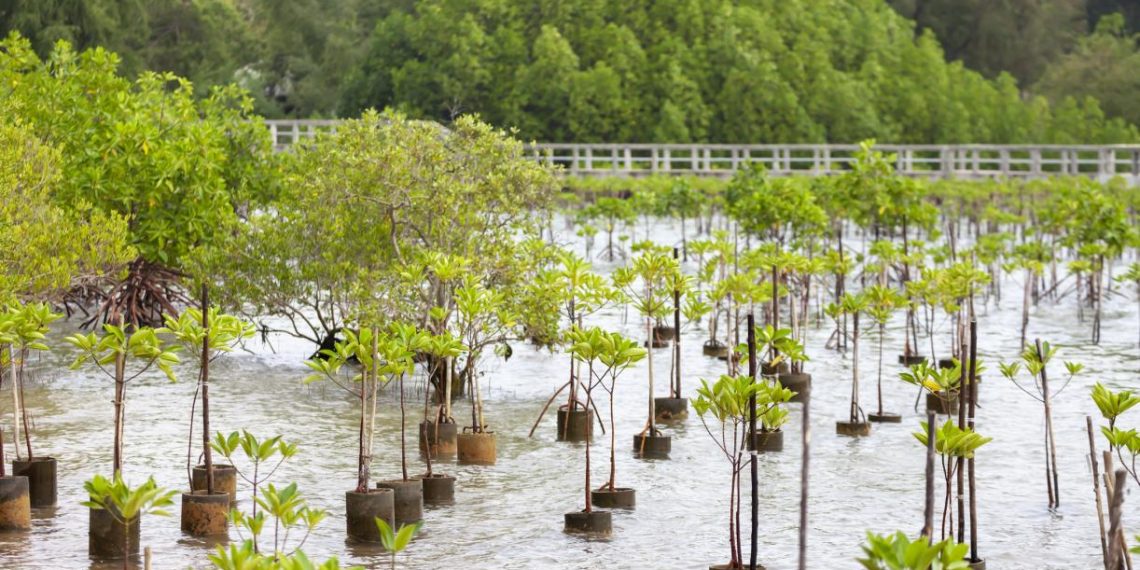The new Intergovernmental Panel on Climate Change report highlights the enormous potential of nature to reduce the risks of climate change and build resilience. Political momentum is building for this approach. For example, 137 countries committed in 2021 to collectively end forest loss and land degradation by 2030 as part of the Glasgow Leaders’ Declaration on Forests and Land Use. Signatories affirmed the importance of all forests in adapting to the impacts of climate change and maintaining healthy ecosystem services. Funding pledges followed, including $19.2 billion to help protect and restore forests globally.
Political momentum and funding for adaptation are also increasing. Current global efforts include $450 million in commitments for “locally led adaptation,” the Adaptation Fund’s announcement of a record $356 million in new pledges, and a $413 million commitment to the GEF’s Least Developed Countries Fund.
As the world faces the urgent need to reduce risk and adapt to current and future climate impacts, it can seize the moment to implement nature-based solutions for adaptation. A new WRI study examines the opportunities.
What Are Nature-based Solutions for Adaptation?
Nature-based solutions are approaches that reverse ecosystem degradation and address societal challenges while also benefitting human well-being and biodiversity. Climate adaptation is the process of adjusting to actual or expected climate change and its effects.
Across ecosystems, many nature-based solutions for adaptation are already protecting communities and nature from climate impacts — from shorter-term hazards such as flooding to longer-term threats like desertification — by strengthening systems’ abilities to withstand impacts or providing services to alleviate risks.
One example of a nature-based solution for adaptation is expanding urban forests and green spaces in cities to combat rising temperatures and heat waves. In Medellín, Colombia, the Green Corridors project demonstrates the effectiveness of this approach, which has resulted in a 2 degrees C (3.6 degrees F) reduction in ambient air temperature since 2018.
Another nature-based solution, restoring mangrove forests, can help protect coastal lives and property because the trees serve as natural physical buffers from storm surges and strong winds. This concept has been applied since 2004 in the Sine Saloum Delta, a biodiversity-rich mangrove ecosystem on Senegal’s Atlantic coast, where more than 100,000 people depend on mangroves for their livelihoods.
Vulnerable and marginalized groups, in particular, stand to benefit greatly from nature-based solutions. These measures can effectively reduce climate risks for women, Indigenous Peoples, the elderly, people living in poverty, people with disabilities, and communities who are directly dependent on natural resources or are physically exposed to climate impacts.
Numerous nature-based solutions for adaptation are already proving their power. They can be 2 to 5 times more cost-effective than business-as-usual interventions — like “gray” infrastructure such as dams, reservoirs and seawalls — and result in greater savings, social benefits and avoided losses. New analysis supported by the UN suggests that using nature-based solutions in infrastructure projects could save $248 billion per year. A recent study by WRI Brasil showed that reforesting 2,500 hectares of priority areas in Vitoria’s river basins would greatly reduce sediment loads, saving the local water utility $26 million over 20 years and making agricultural lands more productive, without the need for added chemicals.
Immediate Opportunities for Nature-based Solutions for Adaptation
Greater political momentum exists now than ever before to invest in and scale nature-based solutions for adaptation. This presents timely opportunities for governments, communities and private companies to take action.
For example:
- Worldwide, more than $90 trillion is being invested in infrastructure that will last for decades to come. This presents a key opportunity to consider how, where and when infrastructure investments can incorporate nature-based solutions to supplement traditional gray infrastructure. In the United States alone, a landmark $1 trillion infrastructure bill could support integration of nature-based solutions into large public works, such as modernizing the nation’s power grid and restoring watersheds. This integration could create hundreds of thousands of jobs and result in infrastructure that holds up better in the face of growing climate risks.
- Many countries reference nature-based solutions for adaptation in their national climate plans under the Paris Agreement (known as “Nationally Determined Contributions,” or NDCs). While there were 324 priorities with linkages to nature-based adaptation solutions in first adaptation components of NDCs, the number increased to 635 in updated adaptation NDCs submitted by December 31, 2021. NDCs are powerful signals of countries’ intentions with regard to climate action – but now is the time to move from intention to action. Nations like The Netherlands are already investing €5.98 billion in water infrastructure, much of which is directed towards nature-based solutions and green infrastructure.
- Commitments and frameworks to put nature-based solutions into action have proliferated in recent years, leading to many international agreements and new financial pledges. In the realm of reforestation and restoration, for example, the second phase of AFR100, the Cities4Forests Call to Action on Forests and Climate, the UN Decade on Ecosystem Restoration, and Initiative 20×20’s Madrid Declaration for Restoration all demonstrate the increased attention to nature-based efforts. These undertakings represent a chance to rachet up ambition and double-down on the synergies with climate adaptation.
- Global events in 2022 will continue to shine a spotlight on nature-based solutions for adaptation, creating more opportunities for action and collaboration. These events include the UN’s annual climate conference (COP27), the UN Biodiversity Conference (Part 2), the 15th UN Conference on Desertification, the World Urban Forum, the UN Ocean Conference, regional climate weeks and more. By building on existing commitments and global interest in nature-based solutions, policymakers can use these opportunities to solidify and institutionalize nature-based solutions at national and subnational levels.
Existing Initiatives Offer Enormous Opportunity to Scale Nature-based Solutions for Adaptation
With the current opportunity to harness nature-based solutions for adaptation, new WRI research underscores the importance of leveraging the potential of already established multi-stakeholder, multi-year and multi-country initiatives focused on nature-based solutions. Dozens of these exist, and they come in different shapes, sizes and levels of formality — from international efforts to small grassroots programs. Most were not designed with adaptation goals in mind, yet are already boosting resilience and improving people’s lives.
For example, CitiesWithNature and Naturvation work with more than 100 cities to integrate nature into city planning, reaching hundreds of millions of urban residents, and the Global Partnership on Forest and Landscape Restoration unites governments around the world with organizations, research institutes and communities around the common goal of restoring degraded landscapes, all helping to boost resilience to a changing climate.
Three nature-based solution initiatives convened by WRI are already working to address adaptation and resilience:
- AFR100 is combatting malnutrition in Malawi by restoring degraded landscapes with moringa, a nutritious tree that can benefit the surrounding ecosystem.
- Cities4Forests is assessing the role of river re-naturalization to mitigate urban floods and stormwater surges in Jakarta, Indonesia.
- Initiative 20×20 is restoring watersheds with native trees in the Colombian Andes. The program aims to strengthen water regulation and filtration, increase water flow, reconnect forest corridors and protect biodiversity.
These and other existing initiatives can play an important role in accelerating investments in adaptation. They are strategically placed to build effective partnerships and channel existing technical capacity, resources and knowledge. They interact with local, subnational and national governments and millions of users across the world, creating an extensive network that connects the public and private sectors and civil society.
Here are five ways that initiatives focused on nature-based solutions can improve how they integrate adaptation:
- Improve coordination among nature-based initiatives to prioritize and integrate climate adaptation efforts. Reducing duplication of effort between initiatives and aggregating projects and expertise can more quickly deliver adaptation outcomes.
- Deepen connections between nature-based initiatives and the climate adaptation community. Sharing adaptation-specific tools and processes with nature-based solutions initiatives can build technical capacity and increase the likelihood of long-term success.
- Continue to invest in pilot projects for nature-based solutions for adaptation. Capitalizing on nature-based solutions platforms’ expertise in accessing and mobilizing finance can attract more funding for adaptation, which can open the door for larger projects.
- Promote the positive impacts that nature-based solutions can deliver to vulnerable groups – such as women, Indigenous People, the elderly, and youth who bear the brunt of climate impacts and ecosystem degradation – to scale the use of nature-based solutions for adaptation outcomes.
- Make a strong case for nature-based adaptation measures by improving monitoring and communication of benefits. Promoting the effectiveness of nature-based solutions can increase the likelihood of funding for adaptation-specific projects.
By taking action now, cities and countries worldwide can realize the enormous potential of nature-based adaptation solutions. Learn more in WRI’s working paper.



